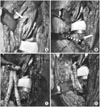Abstract
An absence or compromise of the medial collateral ligament that occurs after primary total knee arthroplasty is a challenging reconstructive problem. Treatment usually requires unlinked-constrained total knee arthroplasty. Revision with unlinked-constrained prostheses often causes more bone loss and transmits increased stress to the bone-cement and prosthesis-cement interfaces, which can increase the risk of aseptic loosening. However, there are no treatment options other than constrained prostheses. We present a 47-year-old female who suffered from medial instability that occurred after total knee arthroplasty, which was treated successfully by a medial collateral ligament reconstruction.
Figures and Tables
 | Fig. 1Preoperative valgus stress view of both knees. Radiographs showed medial instability of the left knee with valgus stress at full extension (A) and at 30° flexion (B). |
 | Fig. 2(A) Intraoperative finding showed a loss of medial collateral ligament at femoral at the tachment site. (B) Intraoperative mild valgus stress provokes abnormal widening of the medial joint space without resistance. |
 | Fig. 3(A) The femoral tunnel (diameter 10 mm and depth 20 mm) was made at the medial femoral condyle. (B) A 10 mm diameter tibial tunnel, which was made anterior to the posterior direction at the medial proximal tibia. (C) A bone block graft was inserted into the femoral tunnel. (D) Two tendinous bundles were inserted into the tibial tunnel. One bundle was passed from the anterior to the posterior direction and the other bundle was passed from the posterior to the anterior direction. Each bundle was then sutured over the other bundle. |
References
1. Bae DK, Lee SH, Park JY. Revision total knee arthroplasty. J Korean Orthop Assoc. 1997. 32:1324–1333.

2. Ha CW, Awe SI. New technique for the reconstruction of both anteromedial & posterolateral bundles of ACL. J Korean Arthroscopy Soc. 2002. 6:195–199.
3. Healy WL, Iorio R, Lemos DW. Medial reconstruction during total knee arthroplasty for severe valgus deformity. Clin Orthop Relat Res. 1998. 356:161–169.

4. Kelly MA. Ligament instability in total knee arthroplasty. Instr Course Lect. 2001. 50:399–401.
5. Krackow KA. Lotke PA, Garion JP, editors. Management of medial collateral ligament loss: repair and augmentation. Revision total knee arthroplasty. 1999. 2nd ed. Philadelphia: Lippincott-Raven;227–249.
6. Lee MC, Seong SC, Moon YW, Kim TG, Kang SB, You JJ. The Results of Revision total Knee Arthroplasty. J Korean Orthop Assoc. 1997. 32:1015–1025.

7. Leopold SS, McStay C, Klafeta K, Jacobs JJ, Berger RA, Rosenberg AG. Primary repair of intraoperative disruption of the medial collateral ligament during total knee arthroplasty. J Bone Joint Surg Am. 2001. 83:86–91.

8. Naudie DD, Rorabeck CH. Managing instability in total knee arthroplasty with constrained and linked implants. Instr Course Lect. 2004. 53:207–215.




 PDF
PDF ePub
ePub Citation
Citation Print
Print




 XML Download
XML Download